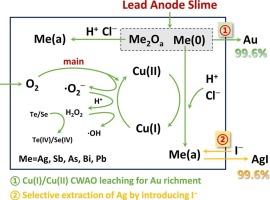Prioritized extraction of gold and silver from lead anode slime by Cu(I)/Cu(II)-based catalytic wet air oxidation leaching method
IF 5
2区 工程技术
Q1 ENGINEERING, CHEMICAL
引用次数: 0
Abstract
Lead anode slime (LAS) is an important industrial by-product containing gold and silver. The traditional treatment method has the problems of long gold and silver recovery process, low direct recycle rate, serious capital backlog, and difficult management of fumes. In this paper, a new strategy for extracting Au and Ag prior from LAS was proposed. The Cu(I)/Cu(II)-based catalytic wet air oxidation (CWAO) technology was used to leach Ag and base metals from LAS to enrich Au first. Then, Ag was selectively precipitated from the leaching solution by introducing NaI. Consequently, the whole extraction process consumed only 1.5 h, and the total recovery rate of Au and Ag were both 99.6 %. The enrichment factor of Au reached 30.2 and the occurrence form in leaching residue may be Au(Te, Se) intermetallic compound. The investigations on catalytic behavior and oxidation mechanism indicate reaction time has a power function with Cu amount. The main path of Cu(I)/Cu(II) redox cycle is the direct oxidation by O2, while the oxidation by reactive oxygen species is the secondary path. Finally, the material flow of Ag, Au, Te, and Se was analyzed. The proposed process provides a reference for extracting of Au and Ag from similar materials.

采用Cu(I)/Cu(II)基催化湿式氧化浸出法优选铅阳极泥中的金银
铅阳极泥是一种重要的含金、银工业副产物。传统的处理方法存在金银回收过程长、直接回收率低、资金积压严重、烟尘治理困难等问题。本文提出了一种从LAS中优先提取Au和Ag的新策略。采用Cu(I)/Cu(II)基催化湿式空气氧化(CWAO)技术从LAS中浸出Ag和贱金属,先富集Au。然后,通过引入NaI选择性地从浸出液中析出Ag。结果表明,整个提取过程仅需1.5 h,金和银的总回收率均为99.6%。金的富集系数达到30.2,浸出渣中的赋存形式可能为Au(Te, Se)金属间化合物。催化行为和氧化机理的研究表明,反应时间与Cu的用量成幂函数关系。Cu(I)/Cu(II)氧化还原循环的主要途径是O2直接氧化,次要途径是活性氧氧化。最后,对Ag、Au、Te、Se的物质流进行了分析。该工艺为从类似材料中提取金和银提供了参考。
本文章由计算机程序翻译,如有差异,请以英文原文为准。
求助全文
约1分钟内获得全文
求助全文
来源期刊

Minerals Engineering
工程技术-工程:化工
CiteScore
8.70
自引率
18.80%
发文量
519
审稿时长
81 days
期刊介绍:
The purpose of the journal is to provide for the rapid publication of topical papers featuring the latest developments in the allied fields of mineral processing and extractive metallurgy. Its wide ranging coverage of research and practical (operating) topics includes physical separation methods, such as comminution, flotation concentration and dewatering, chemical methods such as bio-, hydro-, and electro-metallurgy, analytical techniques, process control, simulation and instrumentation, and mineralogical aspects of processing. Environmental issues, particularly those pertaining to sustainable development, will also be strongly covered.
 求助内容:
求助内容: 应助结果提醒方式:
应助结果提醒方式:


